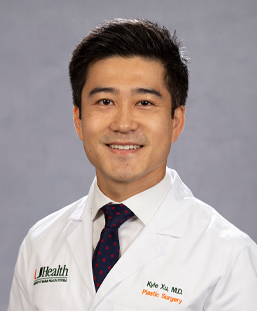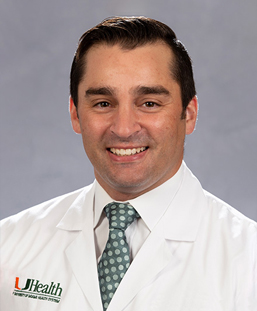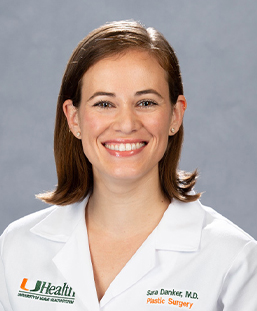Appointments
Call or click for an in-person or virtual visit.
Call us at
1-888-LYMPHUM (596-7486)
Or
We offer comprehensive lymphedema treatment, including advanced microsurgery. These surgeries include lymph venous bypass to redirect fluid into your veins, and vascularized lymph node transplant to move lymph nodes from other areas of your body to the limb where you experience lymphedema.
For advanced lymphedema, we also offer liposuction, to remove excess fat that can build up because of lymphedema. We also offer excision surgery to remove fibrosis that lymphedema can cause.
All of these surgical options can improve your quality of life, function, and comfort when physical therapy or compression are not effective enough.
Surgical Treatments
LYMPHA or Immediate lymphatic reconstruction
This is a procedure performed by a plastic surgeon specializing in lymphatic microsurgery to decrease your risk of developing lymphedema after lymph node removal. It is usually performed at the same time as your cancer surgery.
In this procedure, the surgeon uses supermicrosurgery techniques and equipment including a high-powered microscope to restore the path of your lymphatic system. The surgeon bypasses damaged lymphatic vessels by connecting the lymphatic channels directly to your veins.
Lymphovenous Bypass
An innovative treatment for lymphedema (build-up of fluid in the arms or legs). It uses specialized microsurgery techniques to help this fluid drain more efficiently, reducing swelling and improving your function and range of motion. Our fellowship-trained plastic and reconstructive surgeons have advanced training in lymph venous bypass. They are the only surgeons in South Florida to offer this procedure.
Who is a Candidate?
To qualify for lymph venous bypass, you should undergo physical therapy and compression treatment for at least six months. If your lymphedema is not improving or your quality of life is not meeting your goals, you may be a candidate for lymphedema surgery.
You should be a healthy weight before your lymphedema surgery. You may not be a good candidate for lymph venous bypass surgery if you have vascular disease in your legs.
During the procedure, you will be asleep under general anesthesia. Anesthesia will help you feel comfortable and avoid pain during your procedure.
Using a specialized microscope, your surgeon will look at the lymphatic channels in your affected limbs, which are less than a millimeter wide. They will use small tools and micro sutures thinner than an eyelash to connect your lymph channels to nearby veins. This helps redirect fluid from your lymph channels into your bloodstream so that it drains more efficiently away from your limb.
The surgery takes about four hours.
After the procedure, you may go home the same day as your surgery or the next morning. Within a week, you’ll attend plastic surgery to help start directing the extra fluid into the new bypass connection. You’ll undergo therapy for about three months, but home maintenance will be important for months afterward. You may also be able to wean off of compression or use compression less often once you complete therapy. You should also experience decreased pain and tightness and better function and range of motion in your limb.
Vascularized Lymph Node Transplant
Vascularized lymph node transplant is an advanced microsurgical treatment for lymphedema. During the procedure, your surgeon removes lymph nodes from other areas of your body and moves them into areas where you may not have lymph nodes due to cancer treatment. The new lymph nodes help improve the flow of lymph fluid and reduce lymphedema swelling, tightness and pain.
This is the only location in South Florida where you can receive vascularized lymph node transplant. Our fellowship-trained, expert surgeons use innovative microscopic techniques to perform this surgery and improve your quality of life.
Who is a Candidate?
Before undergoing vascularized lymph node transplant, you should complete physical therapy and compression treatment for at least six months. If your lymphedema is not improving or your quality of life is affected, you may be a candidate for lymphedema surgery.
You should be at a healthy weight before your lymphedema surgery.
During your procedure, you will be asleep under general anesthesia. You will be monitored the whole time by an anesthesiologist to ensure you are safe.
Your surgeon will first remove the lymph nodes from the donor area, often from your neck, clavicle area or, back. To remove them, they will use a specialized microscope and tools to disconnect the lymph channels and veins—which are less than a millimeter wide. They will prepare them to move to the new area, where you are missing lymph nodes.
Next, they will use the same microscope to carefully connect the lymph nodes to the veins, arteries, and lymph channels in your limb, using micro sutures that are thinner than eyelashes. This helps the lymph node be healthy and start to function in the new area.
After this procedure, you will need to stay in the hospital for three to five days to ensure you have good blood flow to the lymph nodes. After a week or two, you’ll begin physical therapy to help direct the fluid to your newly placed lymph nodes. You’ll have to continue treatment for three months as well as a home maintenance program. After one year, you may be able to start weaning off compression or use compression less often. You should experience less pain, less tightness, less swelling, and improved function, and range of motion in your limb.
Liposuction
When extra lymphatic fluid spills into the surrounding tissues, it can cause inflammation and make fat cells grow. To treat this, a plastic surgeon specializing in lymphedema can perform liposuction to remove the extra fat caused by lymphedema.
After the procedure, you will stay overnight in the hospital and get rewrapped by our certified lymphedema therapist the following day.
You can start walking right after the procedure. Start lymphatic therapy within a few days after surgery. Your arm or leg will be wrapped in bandages immediately after surgery. You may shower in these bandages as they are difficult to remove. When you see your therapist, s/he will change the bandages.
At first, the swelling may get worse because of the surgery, but over a few months, you should start to see improvement. You will keep seeing your therapist for wrapping and therapy to help with swelling, and eventually, you will be fitted for new compression sleeves or stockings to maintain the results.
Meet Your Team

Aesthetic Plastic Surgery
Hand Surgery
Microvascular Plastic Surgery
Reconstructive Plastic Surgery
Plastic Surgery

Cutaneous (Skin) Surgical Oncology
Aesthetic Plastic Surgery
Breast Surgery
Microvascular Plastic Surgery
Reconstructive Plastic Surgery
Plastic Surgery
Questions? We're here to help.
Our appointment specialists are ready to help you find what you need. Contact us today.


